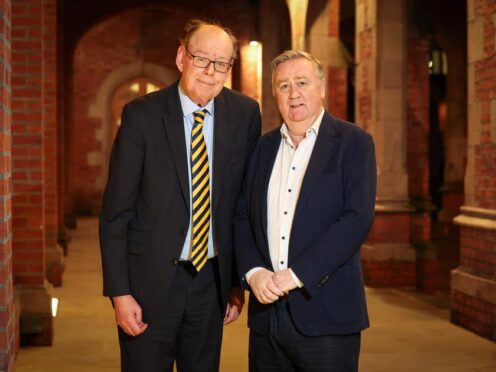Tributes have been paid to veteran Northern Ireland journalist Stephen Grimason following his death at the age of 67 after an illness.
The former BBC Northern Ireland political editor etched his face into history as he broke the news in April 1998 of the historic Belfast/Good Friday Agreement.
Mr Grimason, originally from Lurgan, Co Armagh, later went on to work for the Stormont administration as director of communications.
He spoke publicly over the last year about his battle with cancer and said he received well wishes from former prime minister Tony Blair among others.
In an interview with the PA news agency at the Queen’s University in January when he, along with former UTV political editor Ken Reid, was honoured with the Chancellor’s Medal for services to journalism, he described leaving it as “a bit of a wrench”, recalling “being surrounded by tremendous people”.
Looking back, he said he had a “seat at the table for an awful lot of pretty dramatic Executive meetings” in the 2000s.
Mr Grimason cut his teeth working in local newspapers including the Lurgan Mail, the Ulster Star in Lisburn and Banbridge Chronicle, as well as regional papers, the former Sunday News newspapers and the News Letter.
Speaking in January at Queen’s University around the then political stalemate, Mr Grimason noted the “tide of Irish and Northern Irish politics goes in and out”, adding: “If you’re not careful and you don’t lead, you’ll be left on the beach.”
He also spoke of covering some of the darkest days of the Troubles, including atrocities within days in January 1992 – an IRA bomb which killed eight construction workers at Teebane, Co Tyrone, and the killing of five people by loyalists at the Sean Graham bookmakers on the Ormeau Road in Belfast.
“I was the first reporter at Teebane. In the end, I think that the big success of the peace process was that actually peace, or an imperfect version of it, did win through,” he said.
Adam Smyth, director of BBC Northern Ireland, paid tribute to Mr Grimason.
He said: “Stephen Grimason possessed the special talents that only the very best editors and correspondents exhibit – the audience always came away from his broadcasts feeling they knew and understood the political landscape better, and they trusted what he had to say.
“Stephen’s list of contacts and sources was so extensive he regularly seemed to be one step ahead of everyone else – including the politicians.
“His contribution to BBC Northern Ireland is deeply appreciated and we offer our sincerest condolences to Stephen’s family.”
